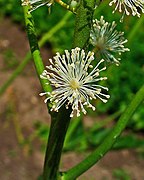Actaea racemosa
| Actaea racemosa | |
|---|---|

| |
| Inflorescence | |
| Scientific classification | |
| Kingdom: | Plantae |
| Clade: | Tracheophytes |
| Clade: | Angiosperms |
| Clade: | Eudicots |
| Order: | Ranunculales |
| Family: | Ranunculaceae |
| Genus: | Actaea |
| Species: | A. racemosa
|
| Binomial name | |
| Actaea racemosa | |
| Synonyms[1] | |
|
Synonymy
| |
Actaea racemosa, the black cohosh, black bugbane, black snakeroot, rattle-top, or fairy candle (
Taxonomy
The plant
Description
Black cohosh is a smooth (glabrous)
The flowers are produced in late spring and early summer on a tall stem, 75–250 cm (30–98 in) tall, forming racemes up to 50 cm (20 in) long. The flowers have no petals or sepals, and consist of tight clusters of 55–110 white, 5–10 mm (0.20–0.39 in) long stamens surrounding a white stigma. The flowers have a distinctly sweet, fetid smell that attracts flies, gnats, and beetles.[9]
The
Cultivation
A. racemosa grows in dependably moist, fairly heavy soil. It bears tall tapering racemes of white midsummer flowers on wiry black-purple stems, whose mildly unpleasant, medicinal smell at close range gives it the common name "Bugbane". The drying seed heads stay handsome in the garden for many weeks. Its deeply cut, superficially maple-like leaves, burgundy colored in the variety "atropurpurea",[11] add interest to gardens, wherever summer heat and drought do not make it die back, which make it a popular garden perennial. It has gained the Royal Horticultural Society's Award of Garden Merit.[12]
The plant was Virginia Native Plant Society’s 2017 wildflower of the year.[13]
Traditional medicine
History
Native Americans used black cohosh in the belief it could treat gynecological and other disorders.[2][10][14] Following the arrival of European settlers in the U.S. who continued the use of black cohosh, the plant appeared in the U.S. Pharmacopoeia under the name "black snakeroot".[2] In the 19th century, the root was used to treat snakebite, inflamed lungs, and pain from childbirth.[15]
Herbalism
Extracts from the underground parts of the plant — the rhizome (Cimicifugae racemosae rhizoma) and the root (Cimicifugae racemosae radix) — are used in herbal medicine. The rhizomes and roots contain various saponins (triterpene saponins and triterpene glycosides, such as actein) as well as cimifugic acids and other phenol carboxylic acids.[3][16]
In most European countries, China, Malaysia, Thailand, Argentina and some other countries, black cohosh products are available as herbal products which have been approved by regulatory authorities ensuring reliable pharmaceutical quality, safety and efficacy for the relief of menopausal complaints such as hot flushes and profuse sweating.[3] In the U.S., India, and some other countries, black cohosh is used as a dietary supplement marketed mainly to women for treating menopausal symptoms and other gynecological problems.[10][17] Meta-analyses of contemporary evidence support these claims on menopausal complaints only for products holding a marketing authorization for this indication,[5] whereas there is no high-quality scientific evidence to support such uses for other products.[14][8][18]
Safety concerns
The Herbal Medicinal Product Committee (HMPC) at the European Medicines Agency (EMA) has summarized the adverse drug reactions of herbal medicines made from cimicifuga with mentioning allergic skin reactions (urticaria, itching, exanthema), facial oedema and peripheral oedema, and gastrointestinal symptoms (i.e. dyspeptic disorders, diarrhoea).[3]
Studies on the long-term safety of using herbal medicines made from black cohosh are available. They do not show harmful effects on breast tissue,
Worldwide, some 83 cases of liver damage, including
Phytochemicals and pharmacology
The rhizomes and roots of black cohosh (Cimicifuga racemosa rhizoma) contain diverse
-
Formononetin, a constituent of methanolic black cohosh[41] extracts but not of commercially available ethanolic or isopropanolic extracts
See also
- Caffeic acid
- Ferulic acid
- List of unproven and disproven cancer treatments
- Phenylpropanoids
- Triterpenoids
References
- ^ "International Plant Names Index". www.ipni.org.
- ^ a b c d e "Black cohosh: Fact sheet for health professionals". Office of Dietary Supplements, US National Institutes of Health. 30 August 2018. Retrieved 14 February 2019.
- ^ a b c d e f Herbal Medicinal Product Committee (HMPC) at the European Medicines Agency (EMA) (2018-03-27). "Assessment report on Cimicifuga racemosa (L.) Nutt., rhizoma" (PDF).
- PMID 24062793.
- ^ S2CID 222143782.
- PMID 28155126.
- ^ JSTOR 1223580.
- ^ a b c d e "Black cohosh". National Center for Complementary and Integrative Health, US National Institutes of Health. 1 September 2016. Retrieved 14 February 2019.
- ^ ISBN 0-9700312-1-1.
- ^ a b c d Predny ML, De Angelis P, Chamberlain JL (2006). "Black cohosh (Actaea racemosa): An annotated Bibliography". General Technical Report SRS–97. Department of Agriculture Forest Service, Southern Research Station: 99. Retrieved 2009-08-24.
- ^ Most “atropurpurea” selections on the market, however, are selections of ‘’Actaea simplex’’.
- ^ "Actaea racemosa". Royal Horticultural Society. Retrieved 5 March 2020.
- ^ Virginia Native Plant Society wildflower of the year 2017
- ^ a b c d "Black cohosh". Drugs.com. 7 June 2018. Retrieved 14 February 2019.
- ISBN 0-394-50432-1.
- ^ PMID 11473444.
- PMID 16884867.
- PMID 22972105.
- S2CID 18872990.
- PMID 21958943.
- PMID 17587516.
- S2CID 25623799.
- ^ PMID 28155126
- ^ Herbal Medicinal Product Committee (HMPC) at the European Medicines Agency (EMA) (2018-03-27). "Assessment report on Cimicifuga racemosa (L.) Nutt., rhizoma" (PDF).
- PMID 21677326.
- ^ S2CID 6221776.
- ^ "Black Cohosh". Cancer Research UK. Retrieved 13 October 2016.
- ^ "Black cohosh (Cimicifuga racemosa): New labelling requirements and consumer information for medicines containing Black cohosh". Therapeutic Goods Administration, Department of Health, Australian Government. 29 May 2007. Retrieved 14 February 2019.
- S2CID 23801005.
- S2CID 25066194
- )
- )
- S2CID 156791.
- PMID 17500365.
- doi:10.7275/R5CR5R84
- )
- )
- ^ OCLC 812923962.






![Cimigenol, a constituent of black cohosh[41]](http://upload.wikimedia.org/wikipedia/commons/thumb/f/ff/Cimigenol_stereo.svg/180px-Cimigenol_stereo.svg.png)
![Formononetin, a constituent of methanolic black cohosh[41] extracts but not of commercially available ethanolic or isopropanolic extracts](http://upload.wikimedia.org/wikipedia/commons/thumb/7/7c/Formononetin-1.svg/180px-Formononetin-1.svg.png)